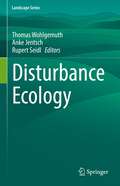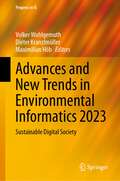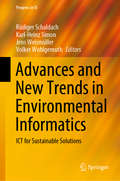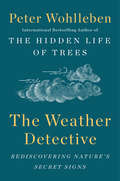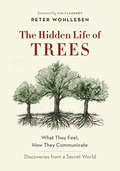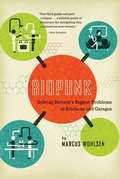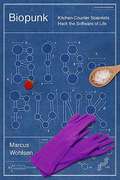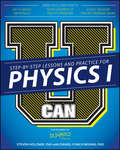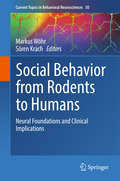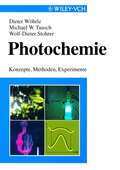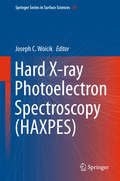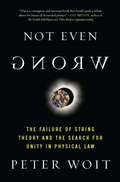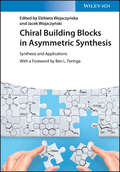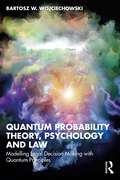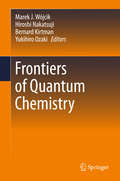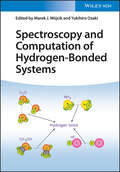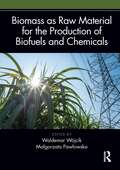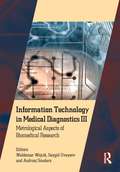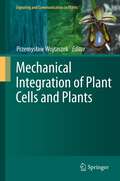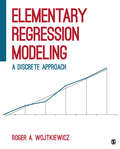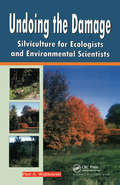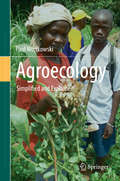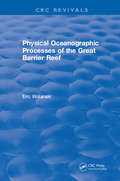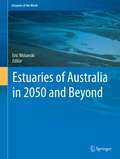- Table View
- List View
Disturbance Ecology (Landscape Series #32)
by Thomas Wohlgemuth Anke Jentsch Rupert SeidlThis edited work presents a multi-faceted view on the causes and consequences of disturbance in ecosystems. Vegetation can be affected by a variety of different disturbances such as wind, floods, fire, and insect attack, leading to an abrupt change in live biomass. Disturbance is a motor of vegetation dynamics, but also sensitive to climate change and poses a challenge for ecosystem management. Readers will discover the global distribution of disturbance regimes and learn about the importance of disturbances for biodiversity and the evolution of plant and animal life. The book provides a Central European perspective on disturbance ecology, and addresses important disturbance agents such as fire, wind, avalanches, tree diseases, insect defoliators, bark beetles and large herbivores in dedicated chapters. It furthermore includes chapters on anthropogenic disturbances in forests and grasslands. The impact of climate change on disturbance regimes and approaches to address disturbance risks in ecosystem management are discussed in concluding chapters. Within the 18 chapters 14 textboxes highlight current topics of disturbance ecology and provide deeper methodological insights into the field. Disturbances strongly shape our landscapes and maintain our biodiversity. A better understanding of their ecology is thus fundamental for contextualizing the dynamic changes in our environment. This book is a valuable resource for students and practitioners interested in disturbances and their management.
Advances and New Trends in Environmental Informatics 2023: Sustainable Digital Society (Progress in IS)
by Volker Wohlgemuth Dieter Kranzlmüller Maximilian HöbThis book is an outcome of the 37th International Conference EnviroInfo 2023, held at the Leibniz Supercomputing Centre (Munich, Germany), organized by the technical committee for Environmental Informatics of the German Informatics Society. It explores the fusion of information and communication technologies with environmental sustainability. As a flagship edition of the EnviroInfo conference series, it showcases the latest advancements in applied informatics and environmental informatics. With a focus on "Towards a Sustainable Digital Society," the conference presents innovative research on topics such as green computing, sustainable software engineering, and digital transformation. The proceedings cover essential subjects for shaping a greener future, including energy-efficient workloads, environmental management systems, legal frameworks, Earth observation, and geographical information systems. It also examines emerging technologies like robotics, AI, and reinforcement learning, highlighting their applications in environmental informatics. From citizen science to disaster risk modeling and sustainable resource management, the book explores the interdisciplinary nature of environmental informatics. It also addresses societal aspects, including its role in developing countries. This resource is essential for researchers, professionals, and policymakers seeking to leverage ICT for addressing environmental challenges and building a sustainable digital society.
Advances and New Trends in Environmental Informatics: ICT for Sustainable Solutions (Progress in IS)
by Volker Wohlgemuth Jens Weismüller Rüdiger Schaldach Karl-Heinz SimonThis book is an outcome of the 33rd International Conference EnviroInfo 2019, held at the University of Kassel, Germany. It presents a selection of papers that describe innovative scientific approaches and ongoing research in environmental informatics and the emerging field of computational sustainability. The respective articles cover a broad range of scientific aspects including advances in core technologies such as earth observation, environmental modelling, big data and machine learning, as well as applications of ICT solutions intended to support societal transformation processes toward the more sustainable management of resource use, transportation and the energy supply. Given its scope, the book is essential reading for scientists, experts and students in these fields of research.
The Weather Detective: Rediscovering Nature's Secret Signs
by Peter WohllebenThe internationally bestselling author of The Hidden Life of Trees shows how we can decipher nature's secret signs by studying the weather.The internationally bestselling author of The Hidden Life of Trees shows how we can decipher nature's secret signs by studying the weather.In this first-ever English translation of The Weather Detective, Peter Wohlleben uses his long experience and deep love of nature to help decipher the weather and our local environments in a completely new and compelling way. Analyzing the explanations for everyday questions and mysteries surrounding weather and natural phenomena, he delves into a new and intriguing world of scientific investigation. At what temperature do bees stay home? Why do southerly winds in winter often bring storms? How can birdsong or flower scents help you tell the time? These are among the many questions Wohlleben poses in his newly translated book. Full of the very latest discoveries, combined with ancient now-forgotten lore, The Weather Detective helps you read nature's secret signs and discover a rich new layer of meaning in the world around you.
The Hidden Life of Trees: What They Feel, How They Communicate --Discoveries from a Secret World
by Peter Wohlleben Tim Flannery<P>In The Hidden Life of Trees, Peter Wohlleben shares his deep love of woods and forests and explains the amazing processes of life, death, and regeneration he has observed in the woodland and the amazing scientific processes behind the wonders of which we are blissfully unaware. Much like human families, tree parents live together with their children, communicate with them, and support them as they grow, sharing nutrients with those who are sick or struggling and creating an ecosystem that mitigates the impact of extremes of heat and cold for the whole group. As a result of such interactions, trees in a family or community are protected and can live to be very old. In contrast, solitary trees, like street kids, have a tough time of it and in most cases die much earlier than those in a group.<P><P> Drawing on groundbreaking new discoveries, Wohlleben presents the science behind the secret and previously unknown life of trees and their communication abilities; he describes how these discoveries have informed his own practices in the forest around him. As he says, a happy forest is a healthy forest, and he believes that eco-friendly practices not only are economically sustainable but also benefit the health of our planet and the mental and physical health of all who live on Earth. <P><b>A New York Times Bestseller</b>
Biopunk: Solving Biotech's Biggest Problems in Kitchens and Garages
by Marcus WohlsenThe most disruptive force on the planet resides in DNA. Biotech companies and academic researchers are just beginning to unlock the potential of piecing together life from scratch. Champions of synthetic biology believe that turning genetic code into Lego-like blocks to build never-before-seen organisms could solve the thorniest challenges in medicine, energy, and environmental protection. But as the hackers who cracked open the potential of the personal computer and the Internet proved, the most revolutionary discoveries often emerge from out-of-the-way places, forged by brilliant outsiders with few resources besides boundless energy and great ideas. In Biopunk, Marcus Wohlsen chronicles a growing community of DIY scientists working outside the walls of corporations and universities who are committed to democratizing DNA the way the Internet did information. The "biohacking" movement, now in its early, heady days, aims to unleash an outbreak of genetically modified innovation by making the tools and techniques of biotechnology accessible to everyone. Borrowing their idealism from the worlds of open-source software, artisinal food, Internet startups, and the Peace Corps, biopunks are devoted advocates for open-sourcing the basic code of life. They believe in the power of individuals with access to DNA to solve the world's biggest problems.
Biopunk
by Marcus WohlsenBill Gates recently told Wired that if he were a teenager today, he would be hacking biology. "If you want to change the world in some big way," he says, "that's where you should start-biological molecules. " The most disruptive force on the planet resides in DNA. Biotech companies and academic researchers are just beginning to unlock the potential of piecing together life from scratch. Champions of synthetic biology believe that turning genetic code into Lego-like blocks to build never-before-seen organisms could solve the thorniest challenges in medicine, energy, and environmental protection. But as the hackers who cracked open the potential of the personal computer and the Internet proved, the most revolutionary discoveries often emerge from out-of-the-way places, forged by brilliant outsiders with few resources besides boundless energy and great ideas. In Biopunk, Marcus Wohlsen chronicles a growing community of DIY scientists working outside the walls of corporations and universities who are committed to democratizing DNA the way the Internet did information. The "biohacking" movement, now in its early, heady days, aims to unleash an outbreak of genetically modified innovation by making the tools and techniques of biotechnology accessible to everyone. Borrowing their idealism from the worlds of open-source software, artisinal food, Internet startups, and the Peace Corps, biopunks are devoted advocates for open-sourcing the basic code of life. They believe in the power of individuals with access to DNA to solve the world's biggest problems. You'll meet a new breed of hackers who aren't afraid to get their hands wet, from entrepreneurs who aim to bring DNA-based medical tools to the poorest of the poor to a curious tinkerer who believes a tub of yogurt and a jellyfish gene could protect the world's food supply. These biohackers include: - A duo who started a cancer drug company in their kitchen - A team who built an open-source DNA copy machine - A woman who developed a genetic test in her apartment for a deadly disease that had stricken her family Along with the potential of citizen science to bring about disruptive change, Wohlsen explores the risks of DIY bioterrorism, the possibility of genetic engineering experiments gone awry, and whether the ability to design life from scratch on a laptop might come sooner than we think. .
U Can: Physics I For Dummies
by Daniel Funch Wohns Steven HolznerTake the fear out of Physics I If the thought of studying physics makes you sweat, you can finally have something to rest easy about! U Can: Physics I For Dummies takes the intimidation out of this tough subject, offering approachable lessons, examples, and practice opportunities-as well as access to additional practice problems online. With this one-stop resource, you'll find friendly and accessible instruction on everything you'll encounter in your Physics I course and will gain the practice and confidence you need to score high at exam time. Inside this comprehensive study resource, how-to lessons are thoughtfully blended with practical examples and problems to help you put your knowledge to practice and gauge your comprehension of the physics topics presented. Lessons and practice problems are fully integrated and track to a typical Physics I course, giving you one mega-resource that combines the 'how-to' you need with the 'do it' practice you want to keep the physics anxiety at bay. Get up to speed on the basic concepts of physics Grasp physics formulas in a clear and concise manner Explore the newest discoveries in the field Access additional practice problems online If you're looking for an all-inclusive product to help with your Physics I coursework, U Can: Physics I For Dummies has it all-and then some!
Social Behavior from Rodents to Humans
by Markus Wöhr Sören KrachThis compelling volume provides a broad and accessible overview on the rapidly developing field of social neuroscience. A major goal of the volume is to integrate research findings on the neural basis of social behavior across different levels of analysis from rodent studies on molecular neurobiology to behavioral neuroscience to fMRI imaging data on human social behavior.
Photochemie: Konzepte, Methoden, Experimente
by Dieter Wöhrle Michael W. Tausch Wolf-Dieter StohrerKompakt, interdiziplinär, praxisorientiert - so präsentiert sich dieses facettenreiche Lehrbuch der Photochemie. Das gut strukturierte und sehr verstandlich geschriebene Werk macht den Leser mit allen bedeutenden photochemischen Prozessen vertraut.
Hard X-ray Photoelectron Spectroscopy (HAXPES)
by Joseph C. WoicikThis book provides the first complete and up-to-date summary of the state of the art in HAXPES and motivates readers to harness its powerful capabilities in their own research. The chapters are written by experts. They include historical work, modern instrumentation, theory and applications. This book spans from physics to chemistry and materials science and engineering. In consideration of the rapid development of the technique, several chapters include highlights illustrating future opportunities as well.
Not Even Wrong: The Failure of String Theory and the Search for Unity in Physical Law for Unity in Physical Law
by Peter WoitWhen does physics depart the realm of testable hypothesis and come to resemble theology? Peter Woit argues that string theory isn't just going in the wrong direction, it's not even science. Not Even Wrong shows that what many physicists call superstring "theory" is not a theory at all. It makes no predictions, not even wrong ones, and this very lack of falsifiability is what has allowed the subject to survive and flourish. Peter Woit explains why the mathematical conditions for progress in physics are entirely absent from superstring theory today, offering the other side of the story.
Chiral Building Blocks in Asymmetric Synthesis: Synthesis and Applications
by Elżbieta Wojaczyńska Jacek WojaczyńskiChiral Building Blocks in Asymmetric Synthesis A comprehensive introduction to the important classes of chiral building blocks Chirality — the asymmetric quality found in certain chemical compounds — plays an essential role in our world: chiral compounds can be found in biology, pharmaceutical compounds, agrochemicals, and fragrances. The stereoselective preparation of these complex molecular constructions constitutes a challenge. To this end, modern asymmetric synthesis utilizes a variety of valuable and efficient reagents employed as chiral auxiliaries, metal complexes and organocatalysts in stereoselective catalysis, and enantiopure reactants termed as chiral building blocks. In Chiral Building Blocks in Asymmetric Synthesis, the achievements in the fields of preparation of and applications of chiral blocks are presented. In doing so, the book comprehensively discusses the important classes of these reactants as the key for the asymmetric synthesis of chiral molecules. As such, it is an indispensable resource about synthetic methods, as well as possible modifications and transformations of important classes of chiral compounds. It also highlights the importance of their use as reactants and auxiliaries in the preparation of more sophisticated molecules or supramolecular systems. In Chiral Building Blocks in Asymmetric Synthesis readers will also find: Organization according to the most important compound classes — e.g. amino acids, BINOL and its derivatives, terpenes, and others — with an emphasis on synthesis and application A focus on the use of chiral building blocks for the preparation of bioactive compounds and supramolecular assemblies Chiral Building Blocks in Asymmetric Synthesis is a useful reference for organic chemists, catalytic chemists, chemists in industry, medicinal chemists, pharmaceutical chemists, and the libraries that support them.
Quantum Probability Theory, Psychology and Law: Modelling Legal Decision Making with Quantum Principles
by Bartosz W. WojciechowskiThis book provides the first consideration of quantum principles in legal decision making. It shows how quantum probability theory can be applied to psychology and law to deepen our understanding of psychological and legal issues, suggesting a paradigm shift in the study of these areas. Written as an introduction to quantum probability theory for non-physicists, the book offers an accessible summary of how psychology can be applied to quantum phenomena for human decision making. It introduces psychologists and lawyers to fresh conceptual frameworks, including classical probability theory, classical statistics, data mining and quantum theory. Wojciechowski shows how quantum theory and concepts can be transferred to psychological research models, and can help to resolve previously unexplained psychological phenomena, influence scientific views, undermine traditional foundations of the legal system and result in the development of new research directions. Studies conducted by the author are used to show how problems facing legal decision making can be addressed in a completely new light with the application of quantum probability theory. This cutting-edge and innovative book will be of great interest to graduate students and researchers in the fields of forensic psychology and legal decision making, as well as legal professionals and legal scholars.
Frontiers of Quantum Chemistry
by Marek J. Wójcik Hiroshi Nakatsuji Bernard Kirtman Yukihiro OzakiThe purpose of this book is to convey to the worldwide scientific community the rapid and enthusiastic progress of state-of-the-art quantum chemistry. Quantum chemistry continues to grow with remarkable success particularly due to rapid progress in supercomputers. The usefulness of quantum chemistry is almost limitless. Its application covers not only physical chemistry but also organic and inorganic chemistry, physics, and life sciences. This book deals with all of these topics. Frontiers of Quantum Chemistry is closely related to the symposium of the same name held at Kwansei Gakuin University at Nishinomiya, Japan, in November 2015. The book's contributors, however, include not only invited speakers at the symposium but also many other distinguished scientists from wide areas of quantum chemistry around the world.
Spectroscopy and Computation of Hydrogen-Bonded Systems
by Marek J. Wójcik Yukihiro OzakiSpectroscopy and Computation of Hydrogen-Bonded Systems Comprehensive spectroscopic view of the state-of the-art in theoretical and experimental hydrogen bonding research Spectroscopy and Computation of Hydrogen-Bonded Systems includes diverse research efforts spanning the frontiers of hydrogen bonding as revealed through state-of-the-art spectroscopic and computational methods, covering a broad range of experimental and theoretical methodologies used to investigate and understand hydrogen bonding. The work explores the key quantitative relationships between fundamental vibrational frequencies and hydrogen-bond length/strength and provides an extensive reference for the advancement of scientific knowledge on hydrogen-bonded systems. Theoretical models of vibrational landscapes in hydrogen-bonded systems, as well as kindred studies designed to interpret intricate spectral features in gaseous complexes, liquids, crystals, ices, polymers, and nanocomposites, serve to elucidate the provenance of spectroscopic findings. Results of experimental and theoretical studies on multidimensional proton transfer are also presented. Edited by two highly qualified researchers in the field, sample topics covered in Spectroscopy and Computation of Hydrogen-Bonded Systems include: Quantum-mechanical treatments of tunneling-mediated pathways and molecular-dynamics simulations of structure and dynamics in hydrogen-bonded systems Mechanisms of multiple proton-transfer pathways in hydrogen-bonded clusters and modern spectroscopic tools with synergistic quantum-chemical analyses Mechanistic investigations of deuterium kinetic isotope effects, ab initio path integral methods, and molecular-dynamics simulations Key relationships that exist between fundamental vibrational frequencies and hydrogen-bond length/strength Analogous spectroscopic and semi-empirical computational techniques examining larger hydrogen-bonded systems Reflecting the polymorphic nature of hydrogen bonding and bringing together the latest experimental and computational work in the field, Spectroscopy and Computation of Hydrogen-Bonded Systems is an essential resource for chemists and other scientists involved in projects or research that intersects with the topics covered within.
Biomass as Raw Material for the Production of Biofuels and Chemicals
by Waldemar WójcikFor the power industry, biomass is just a modern name for the ancient material of plant origin that was converted into energy in the simple technology of burning. This book discusses biomass as a raw material for the production of liquid or gaseous biofuels and valuable chemicals. Such biomass processing should be beneficial from both economic and environmental points of view. Classic technologies of biogas production are still being improved, but they always generate waste that differs in terms of chemical parameters, depending on the feedstock digested. These parameters dictate the manner of their final managing. Various biotechnologies allow the use of the biomass of hydrobionts, such as cyanobacteria as a raw substance for obtaining different products, e.g. hyaluronic acid, biopolymers, fertilizers, or even drugs. Animal fats or algae can be used to produce biodiesel which in turn is used in environmentally friendly urban transport. Even municipal solid waste can be a source of useful biomass. The authors show how its volume and composition can be predicted, by which form of processing it can be converted into valuable products, as well as in which ways its negative environmental impact can be limited.
Information Technology in Medical Diagnostics III: Metrological Aspects of Biomedical Research
by Waldemar WójcikThe science of biomedical measurements is experiencing a period of rapid development. Biomedical measuring systems are becoming increasingly accurate on the one hand and complex on the other. In order to make progress in this field, metrological problems must be solved using a systemic and formal approach. To this end, it is necessary to define the components of the system and the rules for their interaction, which allows the creation of a mathematical model. In this way, any technology or object can be presented in the form of a structure on which the necessary estimates can be formulated and synthesis, including metrological one, can be made. The authors have observed that despite the significance of the problem, few scientific centres deal with this issue in a generalised manner. Hence the idea of bringing together the achievements of the centres from Russia, Poland and Kazakhstan in one joint publication. The first and second volumes of Information Technology in Medical Diagnostics found readers not only in Poland, Ukraine, and Kazakhstan but also Spain, Russia and the Czech Republic. Following the readers’ suggestions, in the third volume of ITMD we returned to the formula of closed chapters known from volume one. Due to its limited volume, the book deals with the aforementioned issues in only selected areas of biomedical engineering. The book will be of interest not only for academics and engineers but also for professionals involved in biomedical engineering, seeking solutions for the problems that cannot be solved using "traditional" technologies or trying to improve existing measurement systems.
Mechanical Integration of Plant Cells and Plants
by Przemyslaw WojtaszekChemical reactions and interactions between molecules are commonly considered the basis of life, and thus the biochemical nature of cells and organisms is relatively well recognized. Research conducted in recent years, however, increasingly indicates that physical forces profoundly affect the functioning of life at all levels of its organization. To detect and to respond to such forces, plant cells and plants need to be structured mechanically. This volume focuses on mechanical aspects of plant life. It starts with a consideration of the mechanical integration of supracellular structures and mechanical properties of cellular building blocks to show how the structural integrity of plant cells is achieved and maintained during growth and development. The following chapters reveal how the functioning of integrated plant cells contributes to the mechanical integration of plants, and how the latter are able to detect physical stimuli and to reorganize their own cells in response to them. The mechanical aspects of plant responses to stresses are also presented. Finally, all these aspects are placed in an evolutionary context.
Elementary Regression Modeling: A Discrete Approach
by Roger A. WojtkiewiczElementary Regression Modeling builds on simple differences between groups to explain regression and regression modeling. User-friendly and immediately accessible, this book gives readers a thorough understanding of control modeling, interaction modeling, modeling linearity with spline variables, and creating research hypotheses that serve as a conceptual basis for many of the processes and procedures quantitative researchers follow when conducting regression analyses.
Elementary Regression Modeling: A Discrete Approach
by Roger A. WojtkiewiczElementary Regression Modeling builds on simple differences between groups to explain regression and regression modeling. User-friendly and immediately accessible, this book gives readers a thorough understanding of control modeling, interaction modeling, modeling linearity with spline variables, and creating research hypotheses that serve as a conceptual basis for many of the processes and procedures quantitative researchers follow when conducting regression analyses.
Undoing the Damage: Silviculture for Ecologists and Environmental Scientists
by P A WojtkowskiAs a natural science, silviculture has a large say in how humans interact with the terrestrial world. Although the perspective taken here that the production of wood is narrow, the amount of land area consumed is extensive; the indirect consequences of wood production on natural processes are larger still. Through the amount of land engaged, the flora and fauna affected and the environmental consequences, good or bad; silviculture is a frequent constituent in applied ecology, environmental science, conservation ecology and other broad land-use disciplines. Silvicultural expertize is essential when trees and wood are an economic output; often best promoted when silviculture is allied with hydrology, ecology, soil science, wildlife management, etc. This book touches upon the following important areas of the subject in detail.
Agroecology: Simplified and Explained
by Paul WojtkowskiThis book presents the core elements that underwrite agroecology. Expressed across twelve chapters, the universality of the core is the essence of agroecology. This alone would be of interest to researchers, students, and academics. Furthermore, the book contains a long, detailed, and inclusive glossary that, with over 160 entries, elaborates on the topics presented. Included are recent developments as well as time-tested, traditional farm practices. The book also advances the theoretical base, fills gaps in the published research, and suggests future opportunities and future directions. The book is internationally oriented, presenting both temperate and tropical agriculture. The book begins by comparing agroecology against conventional, monoculturally-based agriculture. In doing so, it defines the unique features of agroecology and their significance in achieving sustainable and environmentally-friendly agriculture. The book goes on to discuss the underlying technologies, the various manifestations of biodiversity, and the risk countermeasures associated with agroecology. This includes the farm landscape as a positive base for ecology, and how, if used well, it can produce major economic growth. The book concludes by summarizing the key findings, and assessing the macro-challenges facing agroecology.
Physical Oceanographic Processes of the Great Barrier Reef: Physical And Biological Links In The Great Barrier Reef
by E. WolanskiPhysical Oceanographic Processes of the Great Barrier Reef is the first comprehensive volume describing the water circulation and its influence in controlling the distribution of marine life on the Great Barrier Reef of Australia. The book uses exhaustive field and numerical studies to show how the influence of the salient topography occurs at all scales.
Estuaries of Australia in 2050 and beyond
by Eric WolanskiThe book addresses the questions: Is Australia's rapidly growing human population and economy environmentally sustainable for its estuaries and coasts? What is needed to enable sustainable development? To answer these questions, this book reports detailed studies of 20 iconic Australian estuaries and bays by leading Australian estuarine scientists. That knowledge is synthesised in time and space across Australia to suggest what Australian estuaries will look like in 2050 and beyond based on socio-economic decisions that are made now, and changes that are needed to ensure sustainability. The book also has a Prologue by Mr Malcolm Fraser, former Prime Minister of Australia, which bridges environmental science, population policy and sustainability.
